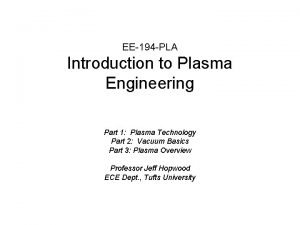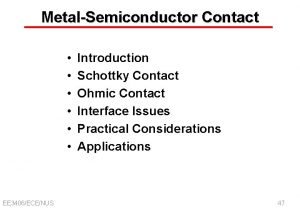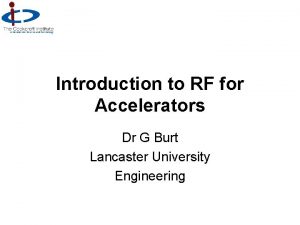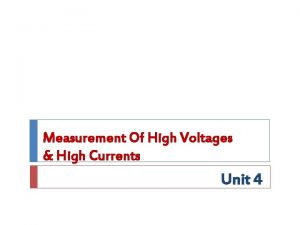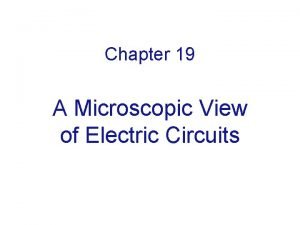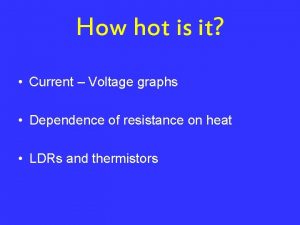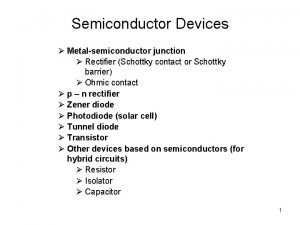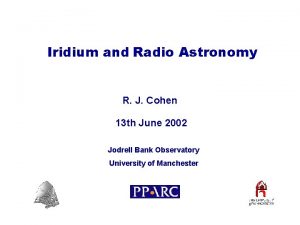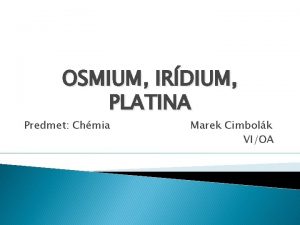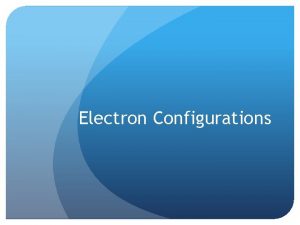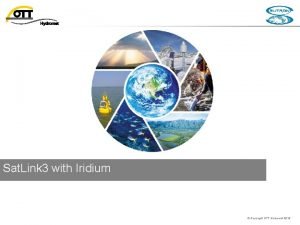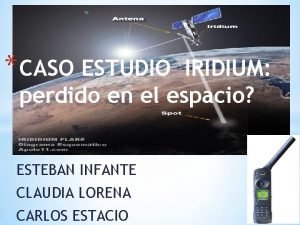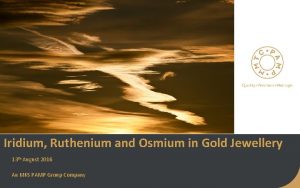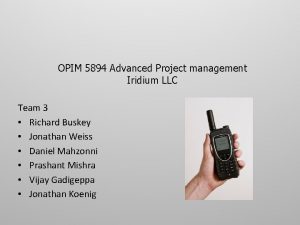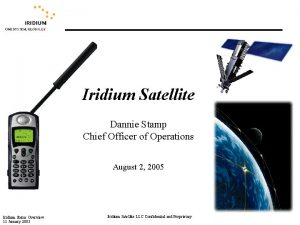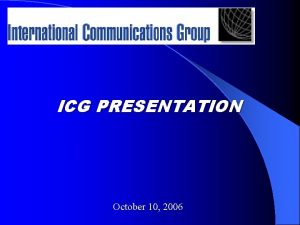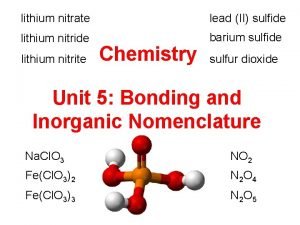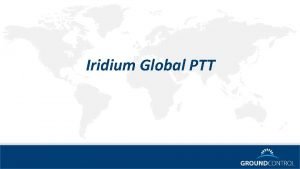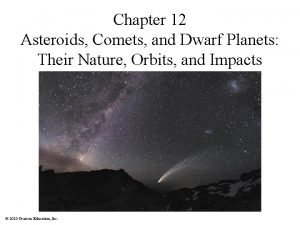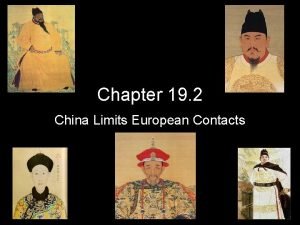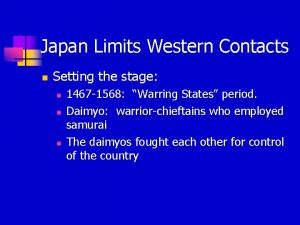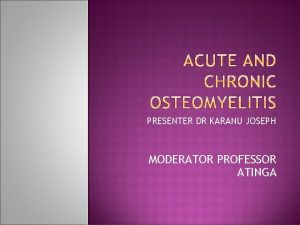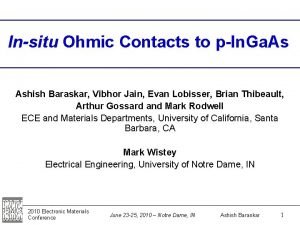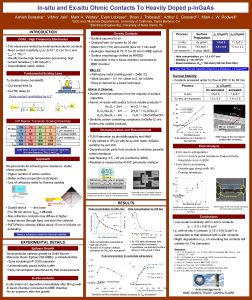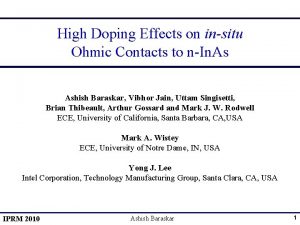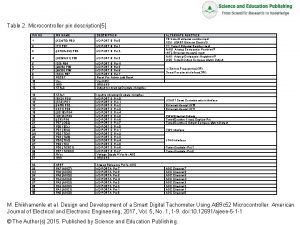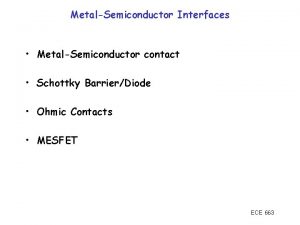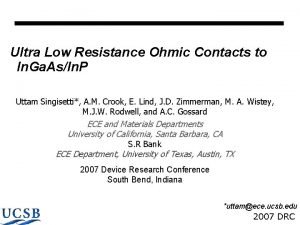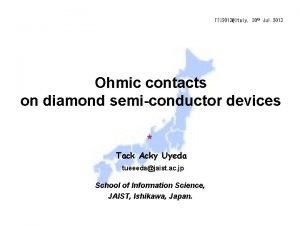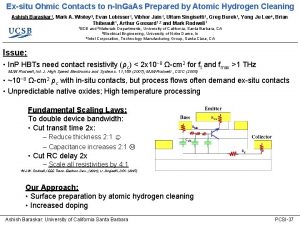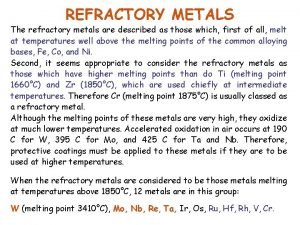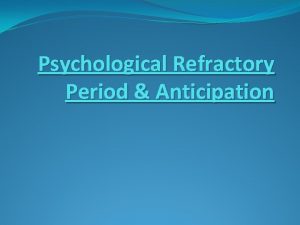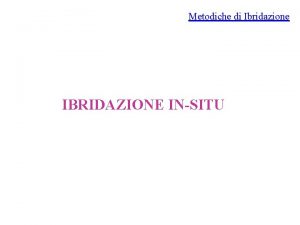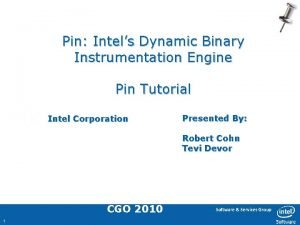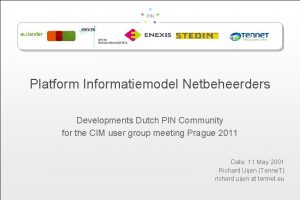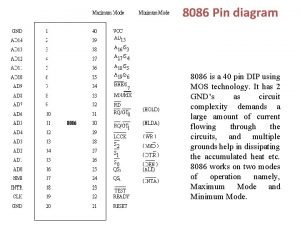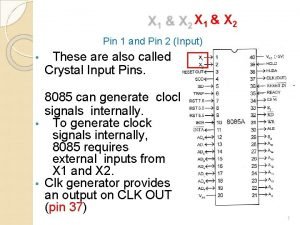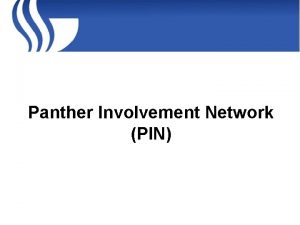Insitu Iridium Refractory Ohmic Contacts to pIn Ga



























- Slides: 27

In-situ Iridium Refractory Ohmic Contacts to p-In. Ga. As Ashish Baraskar, Vibhor Jain, Evan Lobisser, Brian Thibeault, Arthur Gossard, Mark J. W. Rodwell University of California, Santa Barbara, CA Mark Wistey University of Notre Dame, IN Ashish Baraskar, UCSB NAMBE 2010 1

Outline • Motivation – Low resistance contacts for high speed HBTs – Approach • Experimental details – Contact formation – Fabrication of Transmission Line Model structures • Results – Doping characteristics – Effect of doping on contact resistivity – Effect of annealing • Conclusion Ashish Baraskar, UCSB NAMBE 2010 2

Outline • Motivation – Low resistance contacts for high speed HBTs – Approach • Experimental details – Contact formation – Fabrication of Transmission Line Model structures • Results – Doping characteristics – Effect of doping on contact resistivity – Effect of annealing • Conclusion Ashish Baraskar, UCSB NAMBE 2010 3

Device Bandwidth Scaling Laws for HBT To double device bandwidth: • Cut transit time 2 x • Cut RC delay 2 x Scale contact resistivities by 4: 1* HBT: Heterojunction Bipolar Transistor Ashish Baraskar, UCSB NAMBE 2010 *M. J. W. Rodwell, CSICS 2008 4

In. P Bipolar Transistor Scaling Roadmap 256 128 64 32 nm width 8 4 2 1 Ω·µm 2 access ρ 175 120 60 30 nm contact width 10 5 2. 5 1. 25 Ω·µm 2 contact ρ 106 75 53 37. 5 nm thick 9 18 36 72 4 3. 3 2. 75 2 -2. 5 V breakdown ft 520 730 1000 1400 GHz fmax 850 1300 2000 2800 GHz Emitter Base Collector m. A/µm 2 current Contact resistivity serious challenge to THz technology Less than 2. 5 Ω-µm 2 base contact resistivity required for simultaneous THz ft and fmax* Ashish Baraskar, UCSB NAMBE 2010 *M. J. W. Rodwell, CSICS 2008 5

Approach - I To achieve low resistance, stable ohmic contacts • Higher number of active carriers - Reduced depletion width - Enhanced tunneling across metal- semiconductor interface • Better surface preparation techniques - For efficient removal of oxides/impurities Ashish Baraskar, UCSB NAMBE 2010 6

Approach - II • Scaled device thin base (For 80 nm device: tbase < 25 nm) • Non-refractory contacts may diffuse at higher temperatures through base and short the collector • Pd/Ti/Pd/Au contacts diffuse about 15 nm in In. Ga. As on annealing Need a refractory metal for thermal stability 15 nm Pd/Ti diffusion Ashish Baraskar, UCSB NAMBE 2010 100 nm In. Ga. As grown in MBE TEM: Evan Lobisser 7

Outline • Motivation – Low resistance contacts for high speed HBTs and FETs – Approach • Experimental details – Contact formation – Fabrication of Transmission Line Model structures • Results – Doping characteristics – Effect of doping on contact resistivity – Effect of annealing • Conclusion Ashish Baraskar, UCSB NAMBE 2010 8

Epilayer Growth Epilayer growth by Solid Source Molecular Beam Epitaxy (SS-MBE)– p-In. Ga. As/In. Al. As - Semi insulating In. P (100) substrate - Un-doped In. Al. As buffer - CBr 4 as carbon dopant source - Hole concentration determined by Hall measurements 100 nm In 0. 53 Ga 0. 47 As: C (p-type) 100 nm In 0. 52 Al 0. 48 As: NID buffer Semi-insulating In. P Substrate Ashish Baraskar, UCSB NAMBE 2010 9

In-situ Ir contacts In-situ iridium (Ir) deposition - E-beam chamber connected to MBE chamber - No air exposure after film growth Why Ir? - Refractory metal (melting point ~ 2460 o. C) - Easy to deposit by e-beam technique - Easy to process and integrate in HBT process flow 20 nm in-situ Ir 100 nm In 0. 53 Ga 0. 47 As: C (p-type) 100 nm In 0. 52 Al 0. 48 As: NID buffer Semi-insulating In. P Substrate Ashish Baraskar, UCSB NAMBE 2010 10

TLM (Transmission Line Model) fabrication • E-beam deposition of Ti, Au and Ni layers • Samples processed into TLM structures by photolithography and liftoff • Contact metal was dry etched in SF 6/Ar with Ni as etch mask, isolated by wet etch 50 nm ex-situ Ni 500 nm ex-situ Au 20 nm ex-situ Ti 20 nm in-situ Ir 100 nm In 0. 53 Ga 0. 47 As: C (p-type) 100 nm In 0. 52 Al 0. 48 As: NID buffer Semi-insulating In. P Substrate Ashish Baraskar, UCSB NAMBE 2010 11

Resistance Measurement • Resistance measured by Agilent 4155 C semiconductor parameter analyzer • TLM pad spacing (Lgap) varied from 0. 5 -25 µm; verified from scanning electron microscope (SEM) • TLM Width ~ 25 µm Ashish Baraskar, UCSB NAMBE 2010 12

Error Analysis • Extrapolation errors: – 4 -point probe resistance measurements on Agilent 4155 C – Resolution error in SEM d. R dd • Processing errors: – Variable gap spacing along width (W) – Overlap resistance Variable gap along width (W) 1. 10 µm 1. 04 µm Lgap d. Rc W Overlap Resistance Ashish Baraskar, UCSB NAMBE 2010 13

Outline • Motivation – Low resistance contacts for high speed HBTs and FETs – Approach • Experimental details – Contact formation – Fabrication of Transmission Line Model structures • Results – Doping characteristics – Effect of doping on contact resistivity – Effect of annealing • Conclusion Ashish Baraskar, UCSB NAMBE 2010 14

Doping Characteristics-I Hole concentration Vs CBr 4 flux Tsub = 460 o. C – Hole concentration saturates at high CBr 4 fluxes – Number of di-carbon defects as CBr 4 flux * Ashish Baraskar, UCSB NAMBE 2010 *Tan et. al. Phys. Rev. B 67 (2003) 035208 15

Doping Characteristics-II Hole concentration Vs V/III flux CBr 4 = 60 mtorr As V/III ratio hole concentration hypothesis: As-deficient surface drives C onto group-V sites Ashish Baraskar, UCSB NAMBE 2010 16

Doping Characteristics-III Hole concentration Vs substrate temperature CBr 4 = 60 mtorr Tendency to form di-carbon defects as Tsub * *Tan et. al. Phys. Rev. B 67 (2003) 035208 Ashish Baraskar, UCSB NAMBE 2010 17

Doping Characteristics-III Hole concentration Vs substrate temperature CBr 4 = 60 mtorr Tendency to form di-carbon defects as Tsub * *Tan et. al. Phys. Rev. B 67 (2003) 035208 Ashish Baraskar, UCSB NAMBE 2010 18

Results: Contact Resistivity - I Metal Contact ρc (Ω-µm 2) ρh (Ω-µm) In-situ Ir 0. 58 ± 0. 48 7. 6 ± 2. 6 • Hole concentration, p = 2. 2 x 1020 cm-3 • Mobility, µ = 30 cm 2/Vs • Sheet resistance, Rsh = 94 ohm/ (100 nm thick film) ρc lower than the best reported contacts to p. In. Ga. As (ρc = 4 Ω-µm 2)[1, 2] 1. Griffith et al, Indium Phosphide and Related Materials, 2005. 2. Jain et al, IEEE Device Research Conference, 2010. Ashish Baraskar, UCSB NAMBE 2010 19

Results: Contact Resistivity - II p = 5. 7× 1019 cm-3 Tunneling p = 2. 2× 1020 cm-3 Thermionic * r ~ constant Emission c Data suggests tunneling High active carrier concentration is the key to low resistance contacts Ashish Baraskar, UCSB NAMBE 2010 * Physics of Semiconductor Devices, S M Sze 20

Thermal Stability - I Mo contacts annealed under N 2 flow for 60 mins. at 250 o. C Before annealing After annealing 0. 58 ± 0. 48 0. 8 ± 0. 56 ρc (Ω-µm 2) Ashish Baraskar, UCSB NAMBE 2010 TEM: Evan Lobisser 21

Summary • Maximum hole concentration obtained = 2. 2 x 1020 cm-3 at a substrate temperature of 350 o. C • Low contact resistivity with in-situ Ir contacts lowest ρc= 0. 58 ± 0. 48 Ω-µm 2 • Need to study ex-situ contacts for application to HBTs Ashish Baraskar, UCSB NAMBE 2010 22

Thank You ! Questions? Acknowledgements: ONR, DARPA-TFAST, DARPA-FLARE Ashish Baraskar, UCSB NAMBE 2010 23

Extra Slides Ashish Baraskar, UCSB NAMBE 2010 24

Correction for Metal Resistance in 4 -Point Test Structure I V V I Error term (Rmetal/x) from metal resistance Ashish Baraskar, UCSB NAMBE 2010 25

Random and Offset Error in 4155 C • Random Error in resistance measurement ~ 0. 5 m. W • Offset Error < 5 m. W* *4155 C datasheet Ashish Baraskar, UCSB NAMBE 2010 26

Accuracy Limits • Error Calculations – d. R = 50 mΩ (Safe estimate) – d. W = 1 µm – d. Gap = 20 nm • Error in ρc ~ 40% at 1. 1 Ω-µm 2 Ashish Baraskar, UCSB NAMBE 2010 27
 A&p flix activity: generation of an action potential
A&p flix activity: generation of an action potential Absolute refractory period and relative refractory period
Absolute refractory period and relative refractory period Ohmic heating
Ohmic heating Thermoelectric cooler
Thermoelectric cooler Rf
Rf Currents unit
Currents unit Microscopic view of electric current
Microscopic view of electric current Current voltage graph for ohmic conductor
Current voltage graph for ohmic conductor Ohmic contact
Ohmic contact Silaba pu
Silaba pu Iridium
Iridium Chmia
Chmia Silver electron configuration
Silver electron configuration Link3
Link3 Caso iridium
Caso iridium Iridium kankernetwerk
Iridium kankernetwerk Iridium jewelry
Iridium jewelry Iridium project failure
Iridium project failure Iridium
Iridium Icg iridium satcom
Icg iridium satcom Ni3 lewis dot structure
Ni3 lewis dot structure Iridium ptt command center
Iridium ptt command center Iridium layer
Iridium layer China limits european contacts
China limits european contacts Japan limits western contacts
Japan limits western contacts Professor atinga
Professor atinga Gatsby chapter 9 summary
Gatsby chapter 9 summary Zupcasta forma
Zupcasta forma


